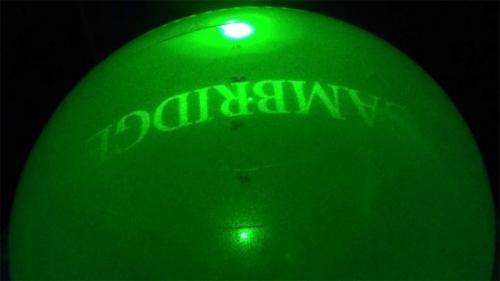Nanotubes used to create smallest ever hologram pixels

(Phys.org)—A breakthrough in the use of carbon nanotubes as optical projectors has enabled scientists to generate holograms using the smallest ever pixels.
Scientists have generated holograms from carbon nanotubes for the first time, which could lead to much sharper holograms with a vastly increased field of view.
The researchers from the University's Centre of Molecular Materials for Photonics and Electronics (CMMPE) have harnessed the extraordinary conductive and light scattering abilities of these tubes – made from several sheets of carbon atoms rolled into a cylinder – to diffract high resolution holograms.
Carbon nanotubes are one billionth of a metre wide, only a few nanometres, and the scientists have used them as the smallest ever scattering elements to create a static holographic projection of the word CAMBRIDGE.
Many scientists believe that carbon nanotubes will be at the heart of future industry and human endeavour, with anticipated impact on everything from solar cells to cancer treatments, as well as optical imaging. One of their most astonishing features is strength – about 100 times stronger than steel at one-sixth the weight.
The work on using these nanotubes to project holograms, the 2D images that optically render as three-dimensional, has been published in the journal Advanced Materials.
"Smaller pixels allow the diffraction of light at larger angles – increasing the field of view. Essentially, the smaller the pixel, the higher the resolution of the hologram," said Dr Haider Butt from CMMPE, who conducted the work along with Yunuen Montelongo.
"We used carbon nanotubes as diffractive elements – or pixels – to produce high resolution and wide field of view holograms."
The multi-walled nanotubes used for this work are around 700 times thinner than a human hair, and grown vertically on a layer of silicon in the manner of atomic chimney stacks.
The researchers were able to calculate a placement pattern that expressed the name of this institution using various colours of laser light – all channelled out (scattered) from the nano-scale structures.
For Haider Butt this is just the start – as these pixels and their subsequent displays are not only of the highest resolution, but ultra-sensitive to changes in material and incoming light.
"A new class of highly sensitive holographic sensors can be developed that could sense distance, motion, tilt, temperature and density of biological materials," said Butt.
"What's certain is that these results pave the way towards utilising nanostructures to producing 3D holograms with wide field of view and the very highest resolution."
For the researchers, there are two key next steps for this emerging technology. One is to find a less expensive alternative to nanotubes, which are financially prohibitive: "Alternative materials should be explored and researched, we are going to try zinc oxide nanowires to achieve the same effects."
The other is to investigate movement in the projections. Currently, these atomic scale pixels can only render static holograms. Butt and his team will look at different techniques such as combining these pixels with the liquid crystals found in flat-screen technology to create fluid displays – possibly leading to changeable pictures and even razor-sharp holographic video.
Journal information: Advanced Materials
Provided by University of Cambridge
















